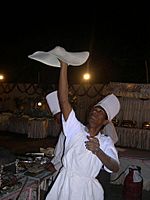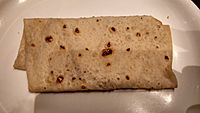Manda roti facts for kids

Manda roti being prepared in India on an upturned vessel
|
|
| Alternative names | Mandige, rumali, or veechu roti |
|---|---|
| Place of origin | |
| Associated national cuisine | Indian |
| Main ingredients | Atta and maida flour |
Manda roti, also known as Rumali roti, is a very thin and soft roti from India. It is so thin that it can be folded like a handkerchief, which is why it's sometimes called "handkerchief bread."
This special bread is made from a mix of whole wheat atta flour and white maida flour. It's cooked on the rounded, outer side of a special pan called a kadahi. You might also hear it called veechu roti in Tamil or Mandige in other parts of South India.
What is Manda Roti?
Manda roti is a traditional Indian flatbread. It is known for being incredibly thin and soft. People often serve it folded up, making it easy to tear and eat with different dishes.
This roti has a long history in India. It is mentioned in ancient Sanskrit writings. These old texts include religious books and cooking guides. They show that this type of bread has been enjoyed for a very long time.
History of Manda Roti
The name Manda roti comes from two old Sanskrit words: Maṇḍaka and Roṭikā. Maṇḍaka was a type of thin, round flatbread made from wheat.
Ancient texts like the Skanda purāṇa describe Maṇḍaka as thin, round cakes made from wheat flour. Another old cooking book, Bhojanakutūhala, even gives a detailed recipe. It says that maṇḍaka was cooked on an upside-down pot.
See also
 In Spanish: Rumali roti para niños
In Spanish: Rumali roti para niños



